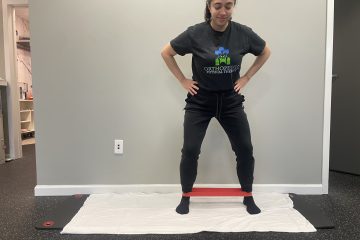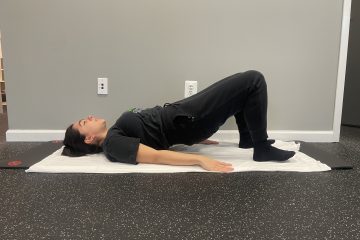 If you’ve ever been pregnant before, you may have experienced the sharp, shooting pain in the front of your pelvis that many refer to as “lightning crotch.” Most often, it happens with a quick step out to the side or with rolling or getting up after sitting for a while. Your OB or your local moms’ facebook group may have told you that it’s your round ligament…. But 0dds are, that’s not actually the case.
If you’ve ever been pregnant before, you may have experienced the sharp, shooting pain in the front of your pelvis that many refer to as “lightning crotch.” Most often, it happens with a quick step out to the side or with rolling or getting up after sitting for a while. Your OB or your local moms’ facebook group may have told you that it’s your round ligament…. But 0dds are, that’s not actually the case.
When we get that sharp, shooting pain at the front of the pelvis, especially if it’s chronic or consistent with certain activities, it’s more likely that it’s pubic symphysis dysfunction, also called SPD (the pubic symphysis joint is also called the symphysis pubis, hence SPD and not PSD). SPD occurs when there is a shifting or pulling happening at the pubic symphysis joint, which can lead to irritation, inflammation, and dysfunction.

Most frequently, SPD occurs during pregnancy with experts estimating that up to 25% of people will experience it at some point during those 40-weeks. But it can also occur outside of pregnancy, stick around postpartum, or be caused by a traumatic accident or injury to the pelvis.
The pelvis is made of three bones, the ilium, the pubis, and the ischium, which come together like puzzle pieces to form three joints: two sacroiliac joints, one pubic symphysis. Each side of the pelvis with those three bones is called an innominate of the pelvis, so we say the pelvis has three innominates brought together by that sacrum. The hips and abdominals also connect to the front and side of the pelvis, often contributing to the pain and difficulty of SPD.

“How do I know if it’s round ligament pain or pubic symphysis dysfunction (SPD)?”
Great question! And it’s good to know the difference so you can seek appropriate treatment if necessary.
 Round ligament pain is a sharp, quick pain that you typically feel on the sides and front of the low abdomen. It can be triggered with quick movements, rolling, or getting up from a chair. The key though is that rest, heat or and/or breathing should alleviate the discomfort within a few minutes. Sometimes it may come on without rhyme or reason and is not typically replicated with specific movements like with SPD.
Round ligament pain is a sharp, quick pain that you typically feel on the sides and front of the low abdomen. It can be triggered with quick movements, rolling, or getting up from a chair. The key though is that rest, heat or and/or breathing should alleviate the discomfort within a few minutes. Sometimes it may come on without rhyme or reason and is not typically replicated with specific movements like with SPD.
 On the other hand, pubic symphysis dysfunction is typically at the very front of the pelvis and sometimes radiates off to one side along the groin or inner thighs. It most often occurs with single leg or transitional activities and will be present the majority of the time when trying to perform those movements. For instance, you may get the sharp, shooting pain in the front of the pelvis every time you roll, try to get dressed, go up and down the stairs, or step out to the side. It does not typically go away with rest and will often get worse if not addressed ASAP.
On the other hand, pubic symphysis dysfunction is typically at the very front of the pelvis and sometimes radiates off to one side along the groin or inner thighs. It most often occurs with single leg or transitional activities and will be present the majority of the time when trying to perform those movements. For instance, you may get the sharp, shooting pain in the front of the pelvis every time you roll, try to get dressed, go up and down the stairs, or step out to the side. It does not typically go away with rest and will often get worse if not addressed ASAP.
Movements that typically make pubic symphysis pain worse include:
- Standing on one leg like when getting dressed or performing certain exercises
- Getting in and out of the car
- Lunging activities or stepping out to the side
- Going up or down the stairs
- Rolling in bed
- Running or cycling
“I think I have pubic symphysis dysfunction, how do I make it better?”
When treating SPD, we typically start with activity modifications. This includes recommendations from your physical therapist on how to reduce that tension and pull on the pubic symphysis. These are not long-term solutions, but ways to decrease pain and start to restabilize the pelvic girdle to help treat the root of the problem.
Common activity modifications for SPD include:
- Sitting down to get dressed or put your shoes on
- Rolling with your knees together or with momentum to reduce the pull on the pelvis
- Getting in and out of the car with knees together
- Reducing your step length (i.e., smaller steps)
- Avoiding lunging activities, single leg activities, or activities where your legs spread apart
Our first goal is to reduce pain and tension in the area so that we can retrain and stabilize. This not only prevents the problem from getting worse, but also helps to set the foundation to improve things in the long-term.
Other strategies that pelvic health physical therapists will implement include:
- Stretches to the abdominals, inner thighs, glutes, and pelvic floor
- Addressing any pelvic floor tension and dysfunction
- Strengthening the abdominals, hips, glutes, and inner thighs to stabilize the pelvic girdle
- Recommending an external support like an SIJ or Serola belt
- Retraining movements to prevent pull on the pubic symphysis
By the end of your time working with a pelvic health physical therapist, you should be able to do ALL the activities that you need or want to be able to do. Modifying activities is never the intention long-term, so after reducing pain, your physical therapist should work with you to get back to everything that you love without pain or discomfort.
Remember, even if you’re currently pregnant, you CAN still address SPD. You do NOT (and should not) have to wait until you give birth to address any pain or dysfunction. In fact, working with a pelvic health physical therapist to address your SPD while pregnant can improve your activity and therefore improve your birth and postpartum outcomes compared to waiting until postpartum. And the longer you wait, the longer it typically takes to make it better.
Curious to learn a little bit more about pubic symphysis dysfunction and how to address the “lightning crotch” during pregnancy or postartum? Schedule your FREE 10-minute consult call today ✨
Be empowered in education,
OrthoPelvic Physical Therapy


